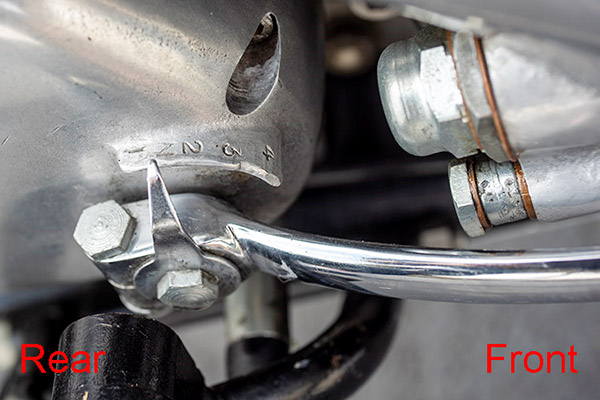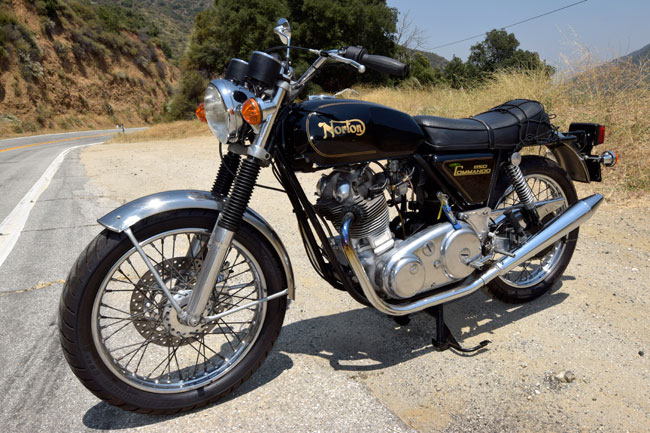Those of you who subscribe to Motorcycle Classics magazine may have seen my article on good buddy Andrew’s Norton P11. I was very proud of that piece and its photos, until I found out that I got a few things wrong. The most significant faux pas was my description of the shift pattern, which I mistakenly assumed was the same as a Triumph’s. All my ‘60s and ‘70s Triumphs were one down, a half click up for neutral, and all the rest up (just like on most of today’s motorcycles). BSA was the same way. When I rode good buddy Steve’s Norton Commando of the same era it was one down and three up. That’s the natural order of things, right?

Ah, not so fast. Norton did it differently. On a Norton, it’s one up and three down. Just like it’s marked on the transmission. Just like my photo above shows.
So why did I get it wrong in the MC article? Chalk it up to old age and carelessness, I guess. I sure am embarrassed about it. I should stick to things that are harder to get wrong (maybe I should be a presidential election pollster for the New York Times).

You might be wondering: What about Steve’s Norton Commando, which had the conventional one down and three up shift pattern? As it turns out, more than a few Norton owners reversed the shift pattern on their bikes to make them like the rest of the world, which can be accomplished by installing a mirror image cam plate in the Norton’s AMC gearbox. That’s evidently what happened to Steve’s bike way before he owned it, and way before I rode it.
Guys who have the original Norton gearbox pattern write that it’s the more natural of the two shift patterns. When you want to go faster, you push down on the shift lever. It’s kind of like stepping on the gas, I guess. Foot down, go faster. Thinking about it, it makes sense.
You know, I didn’t think too much about the Norton’s controls layout when I wrote the P11 article (and obviously, what little thinking I did was not enough). I wrote another MC story about a 1913 Thor several issues back, and if I would have made a mistake, I would have thought it would be in that article. On that one, I had to study my photographs and think about what each lever, pedal, valve, and twist grip did (and there were a lot of each); there was no one to explain it all. After I had done that, I actually found a guy who owned a 1914 Thor (how many of them can there be?) and he told me I had it right. But on that Norton…I’ve ridden a Norton, I’ve owned a bunch of Triumphs and one BSA, and I just never thought I’d get it wrong. But I did. Mea culpa.
Oh, two more things:
-
-
- Merry Christmas and Happy Hannukah. They’re both on the same day this year, which is very unusual.
- That photo at the top of this blog? That’s the P11A, Andrew (on the left), and good buddy Harry (aka the Norton Whisperer).
-
Join our Facebook ExNotes page!
Never miss an ExNotes blog:



Happy Holidays and God Bless America !
Amen, Brother. Enjoy the day.
Merry Chrismukka!
Thanks, Tony. All the best.
Rented a Hodaka once at a dirt bike track in Jacksonville back in the 70s. It had the reverse shift pattern from the Yamahas DTs I had owned. Needless to say I ended up over revving the heck out of that poor Wombat in quite a few places on the track…..good times.
You need to lay off the Yoo Hoo, Fred.
It was the 70s in college…scotch instead of Yoo-Hoo. And lots of trips to the Disco.
I might have seen you in the disco.
I didn’t notice the mistake.
Have a good holiday .
Thanks, Hack. Best wishes to you, too.
My ’73 850 Norton was one down, three up from the factory.
Were you possibly riding it upside down?
You did a good thing, Joe Berk. The minor shift pattern glitch takes nothing away from your wonderful column, and the light shone upon this special machine. Greatly appreciate the words and photos, and thanks for putting into print my beloved Ranger.
Thanks, Andrew. It is a beautiful motorcycle.
That’s how the brain works. You do something thousands of times and eventually one slips through the cracks, like making a bad bullet. Let’s make a resolution not to do it again.